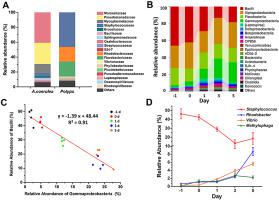Environmental Research ( IF 7.7 ) Pub Date : 2020-06-26 , DOI: 10.1016/j.envres.2020.109843 XinTong Chen 1 , XiaoYa Li 1 , Zheng Xu 2 , Qing Liu 3 , ZhaoYun Peng 1 , YiNa Zhu 1 , JianPing Hong 4 , Wei Lu 5 , Jianguo Cui 1 , Liang Xiao 1

|
Radiation (e.g., nuclear leakage) is a common harmful factor in the ocean that potentially affects the microbial community in nearby benthic hosts such as jellyfish polyps, which is essential for the maintenance of jellyfish populations and high-quality medusae. After comparison with the microbial community of medusae, the effect of 60Co-γ on the microbial community in Aurelia coerulea polyps was dynamically tested using 16S rRNA gene sequencing. Our results suggested that Proteobacteria (76.19 ± 3.24%), Tenericutes (12.93 ± 3.20%) and Firmicutes (8.33 ± 1.06%) are most abundant in medusae, while Proteobacteria (29.49 ± 2.29%), Firmicutes (46.25 ± 5.59%), and Bacteroidetes (20.16 ± 2.65%) are the top three phyla in polyps. After 60Co-γ radiation, the proportion of Proteobacteria increased from 29.49 ± 2.29% to 59.40 ± 3.09% over 5 days, while that of Firmicutes decreased from 46.25 ± 5.59% to 13.58 ± 3.74%. At the class level, Gammaproteobacteria continually increased during the 5 days after radiation exposure, whereas Bacilli declined, followed by partial recovery, and Alphaproteobacteria and Flavobacteriia remained almost unchanged. Intriguingly, Staphylococcus from Firmicutes and three other genera, Rhodobacter, Vibrio, and Methylophaga, from Proteobacteria greatly overlapped according to their KEGG functions. It is concluded that the microbial community in A. coerulea polyps is distinct from that in the medusae and is greatly affected by 60Co-γ exposure, with a growth (0 ∼ 3 d) period and a redistribution (3 ∼ 5 d) period. The dynamic change in the microbial community is probably an important self-defense process in response to external interference that is regulated by the host's physiological characteristics and the intense interspecific competition among symbiotic microbes with similar functions and functional redundancies.
中文翻译:

暴露于60Co-γ射线后,蓝藻的息肉与水母的独特微生物群落及其动力学。
辐射(例如核泄漏)是海洋中常见的有害因素,有可能影响附近海底宿主(例如水母息肉)中的微生物群落,这对于维持水母种群和优质水母至关重要。与水母的微生物群落比较后的效果,60共同γ上的微生物群落奥里利亚犁头息肉使用16S rRNA基因测序动态测试。我们的研究结果表明,水母中的细菌最多(Proteobacteria(76.19±3.24%),Tenericutes(12.93±3.20%)和Firmicutes(8.33±1.06%),而Proteobacteria(29.49±2.29%),Fimerticutes(46.25±5.59%),拟杆菌和拟杆菌(20.16±2.65%)是息肉中的前三个门。经过60Co-γ射线在5天之内的比例从29.49±2.29%增加到59.40±3.09%,而Firmicutes的比例从46.25±5.59%减少到13.58±3.74%。在全班水平,γ-变形杆菌在放射线暴露后的5天内持续增加,而芽孢杆菌则下降,随后部分恢复,而α-变形杆菌和黄细菌几乎保持不变。有趣的是,来自Firmicutes和其他三个属(来自变形杆菌的Rhodobacter,Vibrio和Methylophaga)的葡萄球菌根据其KEGG功能有很大的重叠。结论是:蓝藻中的微生物群落息肉是在水母从不同的且由有很大的影响60共同γ曝光,与生长(0〜3 d)期间和再分布(3〜5 d)周期。微生物群落的动态变化可能是响应外部干扰的重要自卫过程,外部干扰受宿主的生理特征以及具有相似功能和功能冗余的共生微生物之间激烈的种间竞争所调节。











































 京公网安备 11010802027423号
京公网安备 11010802027423号